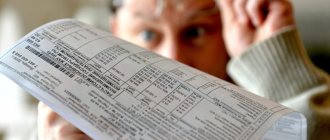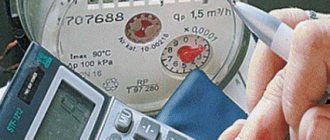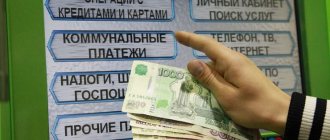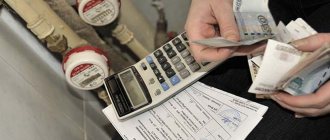Paying utility bills is a rather hot topic for many Russians, as tariffs are constantly rising. In view of this, many are beginning to look for various methods of saving. Among them there are both actually working schemes and options that are clearly not worth using due to possible associated problems.
ORDER A SERVICE FROM ACCREDITED COMPANIES
One of the methods of saving is to pay not according to meters, but according to the number of registered people. However, before choosing this scheme, you need to understand exactly what services are paid for, based on the number of registered people, and what the tariffs may consist of.
What is included in utility bills
Housing and communal services provide for providing comfortable living conditions for citizens in apartment and private buildings. This process is controlled by management companies (MCs), which enter into contracts for the supply of necessary resources.
Before talking about calculating utility bills, you need to consider what is included in their list:
- water supply and sanitation;
- gas;
- electricity;
- heating the room.
Additionally, you need to study payments for the maintenance of the property, maintenance of the intercom, elevator, concierge, major repairs - all this is also included in the payment for housing and communal services.
Note! The management company is responsible for supplying and providing residents with the necessary resources; accordingly, the residents themselves must only promptly pay fees for the above services.
The management company is responsible for calculating payments for utility services.
It is also necessary to understand that common utilities (gas, water, electricity and heating) are provided in all houses, but additional services may vary. For example, not all apartment buildings have a concierge or intercom, which requires a service fee.
Dependence of the quarterly fee on the number of people
As a rule, in the absence of numerical devices, owners have to pay based on the number of people whose residence is officially registered. After new persons are registered as apartments, the minimum payment is automatically changed (increased). Therefore, in order to save money, citizens try to immediately remove from apartment registration persons who do not actually live on the square meters. This is especially true for landlords providing housing under a commercial lease agreement.
Types of payments
The payment document reflecting the list of paid services is a receipt, which is sent to the homeowner on a monthly basis. However, a detailed calculation of housing and communal services payments is not included in this document. It only indicates the types of services, indicating consumption rates and meter readings. Before paying, you need to clarify whether the invoice is correct.
Speaking directly about the general receipt for payment of utilities, it is necessary to indicate what types of payments should be included in the document in question:
- tariffs for water supply and sewerage, latest meter readings, or average cost per month;
- heating (in some houses it is calculated only during the heating season and is based on tariff indicators, and in some all year round in a single set amount);
- gas supply and maintenance, which also assumes an average indicator, or the results of reading the meter;
- electricity, which is reflected in the form of kW indicators per month;
- major repairs;
- maintenance of common property.
If additional services are available, the management company will also issue invoices for payment according to the tariffs.
Note! The receipt must contain information about the payer, the square footage of the premises and the personal account number. In addition, it is necessary to indicate tariffs and background information, otherwise the payment document cannot be considered correct.
Separate mention should be made about each type of payment, since they have their own characteristics of calculating payment and establishing average consumption indicators and tariffs.
For housing services
This category includes payments related to the maintenance of common property. There are no counter indicators provided here. The management company sets tariffs for intercom maintenance, cleaning, property maintenance, garbage removal, and so on. In this case, the cost should be determined according to the standards established by the region.
The cost of housing services is also confirmed by contracts with such suppliers. For example, the management of solid waste, that is, garbage removal, is provided by the relevant company of the city, with which the management company enters into an agreement, negotiates a price, and then, based on the agreement, issues an invoice to the homeowner.
For utilities according to standards
The list of utility bills includes payment for those services for which it depends either on the amount of consumption or on average standards. If the homeowner does not have metering devices, then the management company issues an invoice based on average indicators.
For example, accounting for the amount of water consumed in an apartment is not provided due to the lack of meters. The Criminal Code determines the average amount of consumption - 5 cubic meters of hot water per month, regardless of whether this amount is actually consumed or not. Accordingly, payment occurs at the regional tariff for 5 cubic meters. The owner can spend less or more hot water, the amount of payment will remain unchanged. The same principle applies when determining the cost of light and gas.
For utilities according to meter readings
The next category of payments is based on readings from utility meters. The amount of the provided payment for housing and communal services is determined according to the amount of gas or light actually used. From here the corresponding payment is formed.
For example, for a month the electricity meter showed consumption of 160 kW. Consequently, the specified amount of electricity will be paid according to the tariff. However, next month the figure may be different. This type of payment is more convenient and correct, but only applies if there are meters in the apartment.
Bonus (commission) wage system
This payment system is usually used for employees on whose work the company’s revenue directly depends. For example, for sales managers, sellers. With such a system, there is usually a small constant part (calculated based on work time), and there is a bonus part, which depends on the revenue in each specific month or on the total amount of issued/paid invoices for a particular sales manager.
We examined the main remuneration systems in their purest form. In practice, these systems are usually found with additions and changes, for example, time-bonus or piece-progressive. Employers themselves develop a payment system depending on the needs of their organization. The main thing is that employees are familiar with local regulations that describe the payment system, and understand what indicators their salary depends on and what parts it consists of.
In the online service Kontur.Accounting, it is easy to calculate salaries, maintain personnel documents, and report on employees. There is also accounting, reporting, financial control and other tools. Test the service for free for the first two weeks of operation.
Try for free
Calculation of the amount of payments for housing and communal services
The cost of housing and communal services is determined using special formulas applied taking into account the types of payments presented above. The process of establishing the amount of utility payments should be considered in detail using the example of specific types of services.
Gas supply
The cost of gas consumed is calculated using formulas that will differ depending on whether the homeowner has or does not have meters.
The following formulas are used for calculation:
- Q*T*N – option if there are no meters. Q is the number of cubic meters of gas consumed, T is the cost of one cubic meter, N is the standard. An example of the calculation is as follows: 8 cubic meters of gas, the cost of one cubic meter is 7 rubles, the current standard is 5. Thus, 10 * 7 * 5 = 350 rubles. This is how the cost of gas per month is determined based on average indicators. The amount of consumption does not actually matter.
- Q*T is an option if there are meters in the apartment. Calculation example: 4 cubic meters of gas and the cost of one cubic meter is 7 rubles. Thus, 4*7 = 28 rubles. That is, regardless of the number of people in the apartment and the standards, the owner will pay for the gas actually used.
It is more profitable to pay for gas supply according to the readings of the consumption meter; in practice, the average standards are always higher than the actual ones.
Electricity
When calculating payments for electricity, the principle of average standards or meter readings also applies. It should be taken into account that the standards are determined according to the number of people living in the apartment. For example, 65 kW is provided for one person. Five people live in the apartment. In the absence of meters, the calculation will be as follows: 65 * 5 * 4 (cost of one kW) = 1,300 rubles. per month.
Another example of calculation based on meter readings: 157 kW per month according to the meter (the number of residents does not matter). Therefore, 157*4 = 628 rubles. per month of using electricity. This option is also considered more economical, since it involves paying for the resources actually spent.
You can save money when paying by meter
Water supply
Here, the procedure for calculating payment for utility services will be different, since water supply requires establishing the cost of several services at once: hot and cold water, sewerage.
The first calculation example assumes that there are no meters in the apartment: the average consumption of cold water is 7 cubic meters, hot water is 2 cubic meters per person; the cost of a cube is 19 and 80 rubles, respectively, drainage is 20 rubles. per cube; Three people live in the apartment. The calculation is as follows:
- hot water: 2*3*80 = 480 rub.;
- cold water: 7*3*19 = 399 rub.;
- water disposal: (7+2)*3*20 = 540 rub.
As a result, the final cost of water supply will be the total amount of the identified indicators, namely: 480+399+540 = 1,416 rubles. per month.
The second example of calculation assumes the presence of meters: in one month 10 cubic meters of cold water and 5 cubic meters of hot water were used, the cost of a cubic meter according to the tariff is also 19 and 80 rubles, drainage - 20 rubles. The number of people living in the apartment does not matter:
- hot water: 5*80 = 400 rub.;
- cold water: 10*19 = 190 rub.;
- water disposal: (10+5)*20 = 300 rub.
Thus, water supply according to metering devices will cost 890 rubles, which is significantly less than the average.
Heating
The procedure for calculating payment for heating includes several options (only in season or all year round, with and without a meter)
This type of service provides for the most complex procedure for determining their cost. There are several formulas for calculating heating fees, which include the following options:
- If there are no meters and heating is provided only during the season: S*T*N, where S is the area of the apartment, T is the tariff, N is the standard. Example: the area is 70 sq.m, the standard is 0.02 Gcal, the tariff is 1,800 rubles, therefore, 70*0.02*1800 = 2,520 rubles.
- In the absence of a meter, but year-round heating. The formula will be different: S*T*N*k (frequency factor of 0.5). The data can be used from the first example, therefore, 70 * 0.02 * 0.5 * 1800 = 1,260 rubles.
- If there is a meter and seasonal payment. The formula is as follows: V1*(S/S1)*T, where V1 is the total resource consumption, S1 is the total area of the apartments. For example, 5,000 sq.m. – total area, tariff – 1,500 rubles, apartment area – 70 sq.m., general house consumption – 120 Gcal. Therefore, 120*(70/5000)*1500 = 2520 rubles.
- If there is a meter and constant payment for the service. Here you will need to determine Vm - the average volume per square meter, which is carried out according to the formula V (volume per year) / 12/5000 (total area). For example, 720 Gcal/12/5000 sq.m. = 0.012. Therefore, 0.012*70 (apartment area)*1500 (tariff) = 1,260 rubles.
An example is also possible if there are meters in both the apartment and the house. Here you will need to multiply Vm by the total Gcal for the month, for example, 1.512*15000 = 2,268 rubles. However, such a system is rarely used.
90% of overage proposals rejected
To what extent are tariffs for the population economically justified? It is often said that we pay less than cost.
Svetlana Razvorotneva: Tariffs are different everywhere. Somewhere they are actually lower than justified, for example in Kamchatka, in the Far East. There, the population pays less, and the lost income is subsidized by regional authorities. Somewhere this happens in disguise. Our tariffs are lower than in many Western European countries, but we actually pay more. Because theft, heat loss, ineffective modernization, worn-out utility infrastructure...
There are those who, I think, live well thanks to tariffs. Now, thank God, we have put an end to the practice of companies that were given a meter of pipe as a resource supplying organization. There is a separate tariff for this pipe, and the participation of an intermediary doubles the cost of services. There were similar stories in the Far East, in the Leningrad region.
Alexey Matyukhin: Setting tariffs is the competence of a constituent entity of the Russian Federation. But I would like to point out that there is not only the desire of the region or a specific company. There is a basis for pricing, methodological recommendations that must be strictly followed.
In 2021, a mechanism was introduced for approval of excesses of indices established by the government with the Federal Antimonopoly Service. In previous years, about two thousand municipalities at the local level agreed on excesses by several times, in some cases, tens of times more than the government gave to the region.
In past years, about two thousand municipalities raised tariffs several times higher than the maximum indices established by the government
We received a flood of requests from the regions, we looked at the documents and 92% of them were returned. That is, the excesses that were planned for this year from July 1 were reduced by 90 percent. They brought us documents: “We are planning, perhaps, in January to establish such and such a standard...”. Or letters from the heads of large cities: perhaps we are planning to conclude a concession agreement in July or August 2021, agree for us to increase tariffs by 35 percent. This is at least not serious.
We would like to point out that we do not agree on the percentage increase. But only the possibility and availability of documents that this can be increased. And what percentage is calculated by the regions. There was not a single refusal from the FAS for the reason that they wanted to increase tariffs too much.
Calculation features
The main feature of calculating the amount of payment for receiving utility services is the establishment of the correct tariffs and consumption standards. You should not think that the management company’s calculations are always correct. Tariffs are publicly available, as are the rules for calculating payments.
Another special feature is that the tariffs are valid for six months, there can be no changes, which also allows you to recalculate and determine the cost of utility resources at any time.
There is no need for gas
It was recently announced that gas tariffs will increase by three percent from August 1. Why not from July?
Svetlana Razvorotneva: We are talking about increasing prices for wholesale consumers, which does not always occur on July 1. This will not affect consumers in any way at this time. An increase in wholesale prices is included when setting the tariff. In the Moscow region, a decision was made to postpone the increase in gas tariffs, but this was a purely social decision of the region.
In Moscow, over the past couple of years, the electricity tariff for those with electric stoves has been growing more than for those with gas stoves. This is usually explained by the desire to equalize tariffs.
Svetlana Razvorotneva: These are regional solutions. They probably have some kind of logic. For me, setting tariffs in Moscow is always a mystery. Why do they always grow faster in Moscow than throughout the country? Although tariffs in Moscow have now been raised by 3.7 percent, they, based on some considerations, made an application for 5 percent.
Alexey Matyukhin: Maximum payments are set according to a methodology approved by the government. In fact, they are approved long-term, there is a certain formula. Indicators of socio-economic development and other points are included there. The increase figure is primarily related to the socio-economic situation of the region, development, active construction, implementation of comprehensive development programs and other points.
Where can you quickly calculate housing and communal services payments?
To apply the formula for calculating the cost of utilities, it is not necessary to make the calculations yourself. It is enough to have meter readings and the cost of services at general tariffs, since the website of the Antimonopoly Service of the Russian Federation has access to a special calculator. With its help, you can determine the amount of payments at the apartment address.
Thus, you can determine the amount of payment for utility services yourself, for which it is enough to know the current tariffs and consumption standards for housing and communal services, or use resource consumption meters, which also simplifies the task of controlling the amount of payments.
Order a free legal consultation
Advanced formula: how to take into account additional payments
If, in addition to salary, an employee receives incentive and compensation payments, an expanded formula is used to calculate wages:
Moreover, if the employee worked all working days in the billing month (KRD = KOD), this formula takes the form:
How to calculate the salary amount if the employee is paid a bonus or other additional amounts? Let's continue the previous example, changing the conditions in it.
Let's assume that the janitor P. G. Samoilov worked in January without any comments or disciplinary sanctions. Then he will receive a bonus (15% of the salary) in addition to his salary. And to calculate wages, you can use an extended formula (without adjusting the salary for days worked):
Salary = 16,250 16,250 × 15% = 18,687.5 rub.









